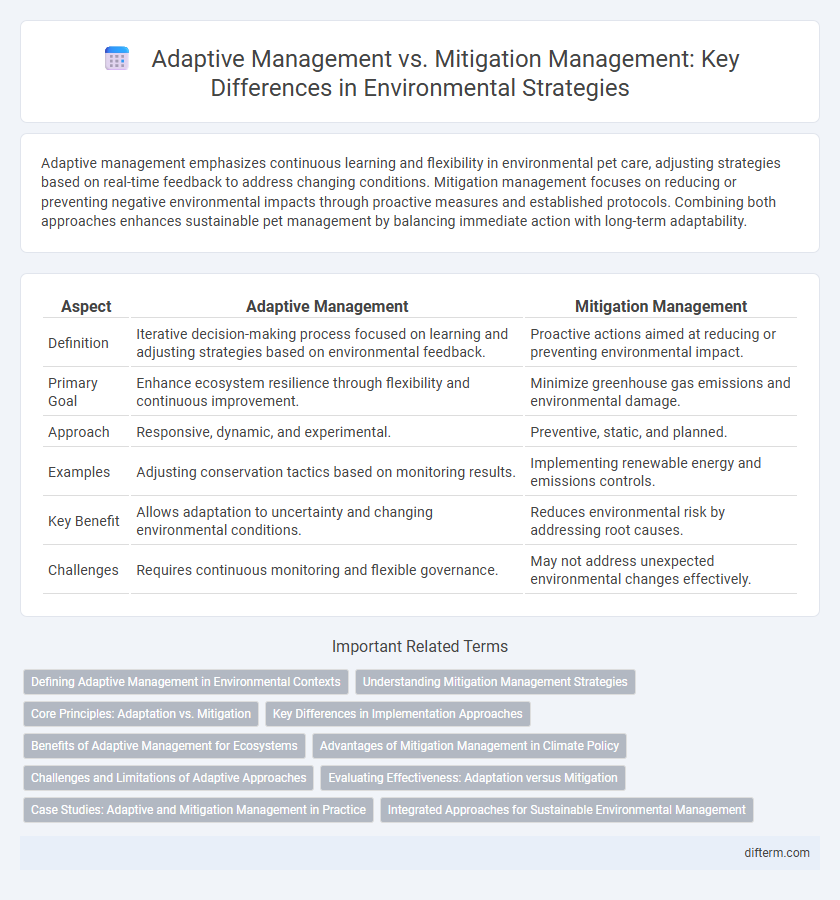Adaptive management emphasizes continuous learning and flexibility in environmental pet care, adjusting strategies based on real-time feedback to address changing conditions. Mitigation management focuses on reducing or preventing negative environmental impacts through proactive measures and established protocols. Combining both approaches enhances sustainable pet management by balancing immediate action with long-term adaptability.
Table of Comparison
| Aspect | Adaptive Management | Mitigation Management |
|---|---|---|
| Definition | Iterative decision-making process focused on learning and adjusting strategies based on environmental feedback. | Proactive actions aimed at reducing or preventing environmental impact. |
| Primary Goal | Enhance ecosystem resilience through flexibility and continuous improvement. | Minimize greenhouse gas emissions and environmental damage. |
| Approach | Responsive, dynamic, and experimental. | Preventive, static, and planned. |
| Examples | Adjusting conservation tactics based on monitoring results. | Implementing renewable energy and emissions controls. |
| Key Benefit | Allows adaptation to uncertainty and changing environmental conditions. | Reduces environmental risk by addressing root causes. |
| Challenges | Requires continuous monitoring and flexible governance. | May not address unexpected environmental changes effectively. |
Defining Adaptive Management in Environmental Contexts
Adaptive management in environmental contexts involves a systematic approach to resource management that emphasizes learning and flexibility by monitoring outcomes and adjusting strategies accordingly. This dynamic process addresses ecological uncertainties and evolving environmental conditions, optimizing conservation efforts and sustainable resource use. It contrasts with mitigation management, which primarily focuses on minimizing harm rather than iterative learning and adjustment.
Understanding Mitigation Management Strategies
Mitigation management strategies prioritize reducing greenhouse gas emissions through initiatives like renewable energy adoption, carbon capture technologies, and reforestation efforts. These approaches aim to address the root causes of environmental degradation by limiting harmful outputs and enhancing natural carbon sinks. Effective mitigation management integrates scientific data and policy frameworks to ensure sustainable and measurable environmental improvements.
Core Principles: Adaptation vs. Mitigation
Adaptive management emphasizes flexible decision-making and learning from environmental feedback to adjust strategies in response to ecosystem changes, prioritizing resilience and sustainability. Mitigation management focuses on reducing the sources or impacts of environmental damage, aiming to limit greenhouse gas emissions and prevent further degradation. Core principles of adaptation revolve around coping with inevitable changes, while mitigation targets the root causes to minimize future risks.
Key Differences in Implementation Approaches
Adaptive management emphasizes iterative learning and flexibility by continuously monitoring environmental projects and adjusting strategies based on new data. Mitigation management focuses on predetermined actions to reduce or prevent environmental damage, relying on predictive models and regulatory compliance. Implementation of adaptive management requires stakeholder engagement and dynamic decision-making, whereas mitigation management depends on strict adherence to established protocols and regulatory frameworks.
Benefits of Adaptive Management for Ecosystems
Adaptive management enhances ecosystem resilience by continuously integrating scientific monitoring and feedback to adjust conservation strategies. This approach improves biodiversity preservation by allowing flexible responses to environmental changes and uncertainties. It supports long-term sustainability by promoting learning and collaboration among stakeholders, optimizing resource use and ecosystem health.
Advantages of Mitigation Management in Climate Policy
Mitigation management in climate policy effectively reduces greenhouse gas emissions by prioritizing long-term sustainability and minimizing future environmental damage. This approach supports clear regulatory frameworks and incentivizes investment in renewable energy technologies. By focusing on prevention rather than reaction, mitigation lowers overall economic costs related to climate change impacts and fosters global cooperation towards emission reduction targets.
Challenges and Limitations of Adaptive Approaches
Adaptive management faces challenges such as uncertainty in ecological responses and the need for continuous monitoring, which demands significant resources and expertise. Decision-making complexities arise from dynamic environmental conditions, making it difficult to predict outcomes and implement timely adjustments. Limitations include stakeholder conflicts and institutional resistance, which can hinder the iterative learning process essential for successful adaptive strategies.
Evaluating Effectiveness: Adaptation versus Mitigation
Evaluating effectiveness in adaptive management centers on flexibility and iterative learning to respond to changing environmental conditions, targeting resilience building in ecosystems and communities. Mitigation management effectiveness is measured by the reduction of greenhouse gas emissions and long-term climate stabilization outcomes, emphasizing the prevention of further environmental degradation. Both approaches require robust monitoring, but adaptation prioritizes real-time adjustments while mitigation focuses on quantifiable emission reductions and policy enforcement.
Case Studies: Adaptive and Mitigation Management in Practice
Case studies in environmental management reveal that adaptive management emphasizes iterative learning and flexibility, allowing ecosystems to respond dynamically to changes and uncertainties. Mitigation management focuses on reducing or eliminating negative environmental impacts through planned interventions, such as carbon offsetting or emission controls. Notable examples include adaptive management in the Everglades restoration, where monitoring informs ongoing adjustments, and mitigation efforts in the Kyoto Protocol's carbon trading mechanisms.
Integrated Approaches for Sustainable Environmental Management
Adaptive management emphasizes continuous learning and flexibility to respond to environmental uncertainties, while mitigation management focuses on reducing or preventing environmental damage through targeted actions. Integrated approaches combine these strategies by using adaptive frameworks to inform mitigation efforts, ensuring sustainability and resilience in ecosystem management. This synergy enhances resource efficiency and supports long-term environmental goals such as biodiversity conservation and climate change resilience.
Adaptive management vs Mitigation management Infographic

 difterm.com
difterm.com